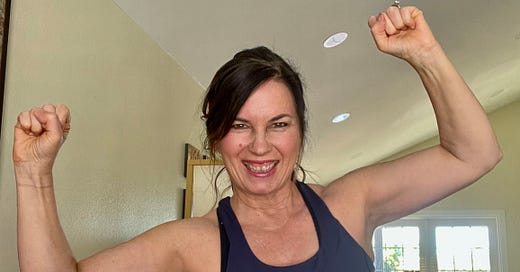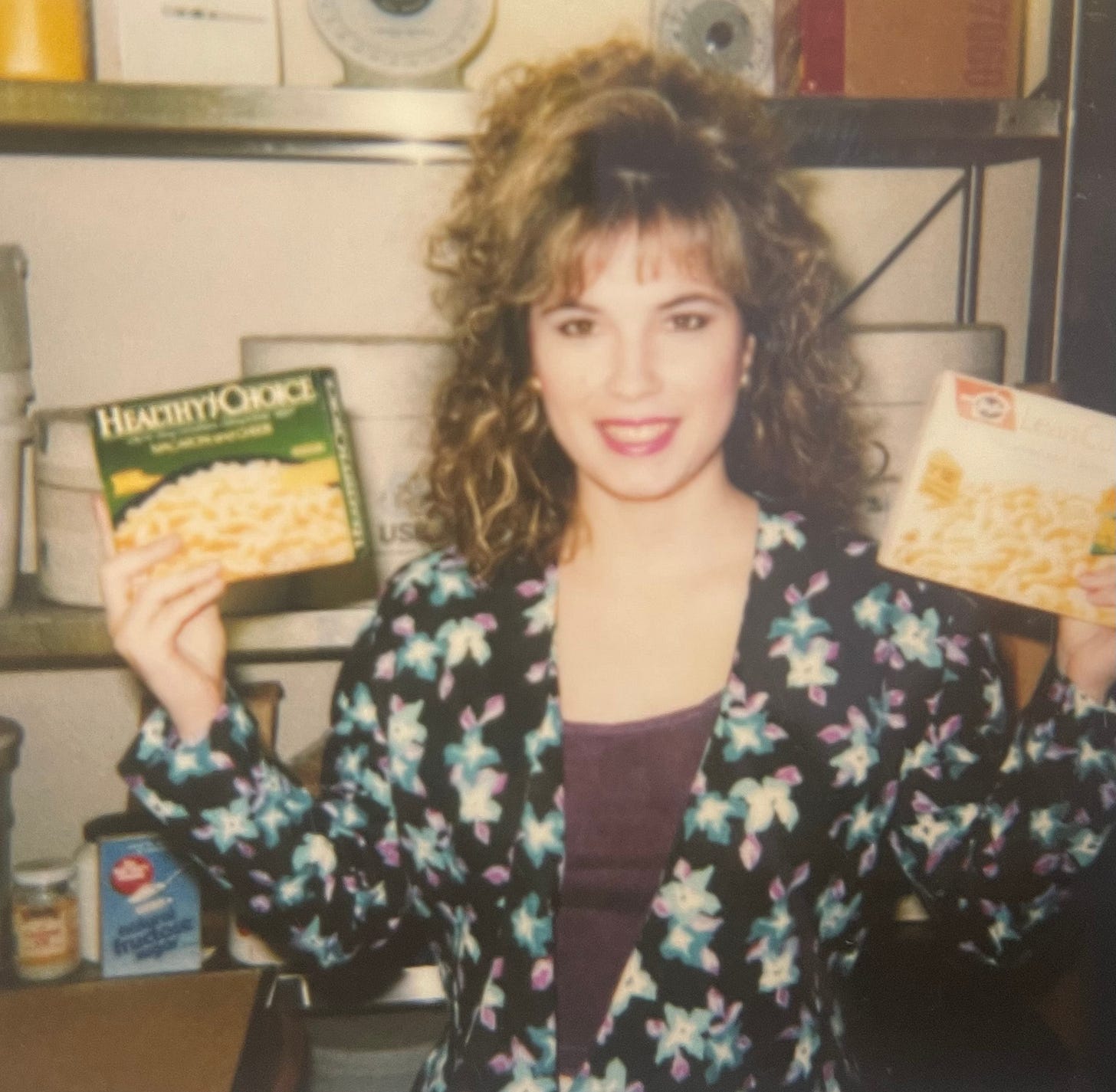My Slow, Unimpressive, Totally Worth-It Strength Journey
The barrier to strength training that a lot of midlife women face
My earliest memory of my strength level dates back to elementary school, during the Presidential Physical Fitness test.
Back then, they tested everyone on how many pushups, pullups, and sit-ups they could do. Only a coveted few got the Presidential Physical Fitness Award.
And that was the first time I saw myself as “weak” and “not as strong” as others.
I mean, I watched as a girl my age effortlessly did pushups and sit-ups and not knowing anything, what else could I conclude?
Funny thing is, I was pretty athletic and was a strong swimmer and softball player. I just lacked that core and upper body strength that is common in girls.
I've been thinking about this lately after talking with friends. Many of us used to prioritize cardio when we were younger, avoiding weightlifting—but now we realize how important building strength really is.
“I never learned how to lift weights,” one friend admitted, as she just bought some weights and is starting a new program.
But knowing strength training is good for us doesn’t always make incorporating it any easier.
What I wish I knew early on
I wish I knew that I hadn’t even started puberty yet, and that likely held me back in the strength area. When girls go through puberty, they gain body fat, muscle, and an increased ability to build strength.
Second, there is a genetic component for strength and muscle mass. Studies show genetics influence strength (30-85%) and muscle mass (50-80%).
Even in elite athletes, researchers have also discovered power/strength phenotypes.
Just like everything in life, some of us get a head start genetically or are more naturally gifted. That doesn’t mean we all can’t make gains, but people rarely discuss this point, especially on social media.
Another thing I wish I knew was that strength training boosts performance in many sports, including the things I enjoyed: softball, cheerleading, and later running.
Think what Tiger Woods did for golf. He was an early adopter of weight training and running to improve his golf game.
My introduction to weights
After high school, my friend and I decided to start working out. My family had a membership at a large gym, and I was immediately drawn to aerobics.
While I was having fun with aerobics, my sister was experimenting with the weight room. Eventually I joined her but at first, I was super intimidated.
But as I learned about each exercise and the body parts being worked, I enjoyed it. Yet at this young age, most of what I cared about was how I looked.
I didn’t focus on getting stronger or adding more weight, for fear of bulking up. Remember, the 80s and 90s were the height of diet culture, before we even knew what that was.
During my twenties and thirties, I always incorporated some type of resistance exercise into my routine, attending classes or working out at the gym. But cardio was the priority, especially when I started running in my late 20s.
I often wonder how much stronger I’d be if I prioritized strength before 30, a time it’s easier to build muscle and increase strength and power. Any weight training I did back then was focused on getting toned—not building muscle or gaining real strength.
READ: Meet Your Protein Needs with These 3 Simple Strategies
Post kids—and the start of midlife
I had my second child three days before I turned 40. For several years, exercise was just about getting to a class, which often included light weights. I’d go for short runs, too.
I kept doing this until I joined an early morning running group, which challenged me to run longer and harder.
One of my running friends is part of a cross fit gym, and she lifts heavy weights. Her gym had a free bootcamp class, and I loved how challenging it was.
I’d been reading up on strength training, and it was clear I needed to balance it with my cardio.
I remember signing up for my first bootcamp membership while on a vacation, the summer after I turned 50.
I loved the workouts, but it was hard to tell if I was getting stronger since they were all so different.
I eventually joined a weightlifting gym to learn more about compound movements like squats and deadlifts and record how much I was lifting.
This is when I made a realization.
The great divide
I was at the weightlifting gym for a year and a half. I learned a lot about proper form and how to lift. But I made an important observation that was eerily familiar to the Presidential Physical Fitness Award experience in grade school.
Some women who never lifted would join and in three months would lift way more than me.
This can be very discouraging when you see small gains while others make huge ones. I came to realize most of the people who stayed at that gym were responding better to the training.
And the ones that weren’t were more likely to leave.
Again, there is a heritability component in strength and muscle mass. And as I dug a little more, I found a genetic link to adverse muscle aging, too.
In a 2021 pilot study, researchers found a significantly higher genetic risk score in those with sarcopenia (62%) and not (39%).
Older adults with a genetic risk score of 58.3% or higher were 1.9 times more likely to have sarcopenia compared to those with a lower score.
These differences are also apparent in body composition. In one study, researchers gave young, trained men and women high-protein diets and 5 days of strength training. On average, there was a gain of 1.5kg lean mass.
Yet some gained as much as 7kg lean mass and others gained very little. About 70% responded to high-protein diets, which means a significant amount (30%), didn’t.
One thing was obvious — we’re not all the same.
READ: Can These Two Exercises Prevent Menopause Bone Loss as Effectively as Hormone Therapy?
This journey is yours—and yours alone
I eventually left that gym, but I never stopped strength training. I simply found an environment that better suited me.
Accepting that my body responds uniquely to strength training has brought me a sense of peace. I’ve learned to go at my own pace, trusting that small, consistent gains would add up. And they have.
I suspect the very women who could benefit the most from strength training end up dropping out because their progress isn’t as quick or visible as others.
But consider this: A 2011 meta-analysis on people over 50 found that resistance training results in an average gain of 1 kg of lean muscle mass. That might not sound like much—but without strength training, we lose about 0.18 kg of muscle every year.
So even maintaining is a win.
If more midlife women understood this, maybe more than 1 out of 5 would regularly strength train.
I wish I had learned all this earlier, even back in grade school. But now I know. I’ve seen my bone density and lean mass increase, and my lifting gains, no matter how small, are very rewarding.
Most importantly, I no longer guilt myself when I see someone lifting heavier or with a visibly leaner body. Good for them. Truly.
Because the only person I need to focus on in the weight room—is me.








during my 20s, 30s, I was stationed in various places around the world. No matter what kind of raggedy arsed weight lifting room there was in my barracks,or one near by, I never lacked for offers of assistance. This wasn't about men hitting on women at the gym. It was men who knew that women had to be strong to pass PT tests, who had daughters that weren't too much younger than I and my friends were. I was happy for their help and advice. Maybe being around mostly men while lifting made me see it differently; a few times I'd go to the gym that offered weight classes and be discouraged by all the beautiful young ladies in their Jane Fonda leotards, styled hair, and beautiful make up and jewelry. I was bad about this; my gear was a faded t shirt and droopy sweatpants, ha!! I could not see the value in getting dressed up only to sweat and press and push. Later, I realized that the gym was a good way for many of those pretty women to have a healthy way to get out of the house, get a break from small children, etc. Good on them!!
Thank you for this! I have lifted regularly for the past year and have seen major changes at 42. I unfortunately tore my labrum in my hip while running and am deep into PT but I am trying to keep on it. Thanks for the motivation!